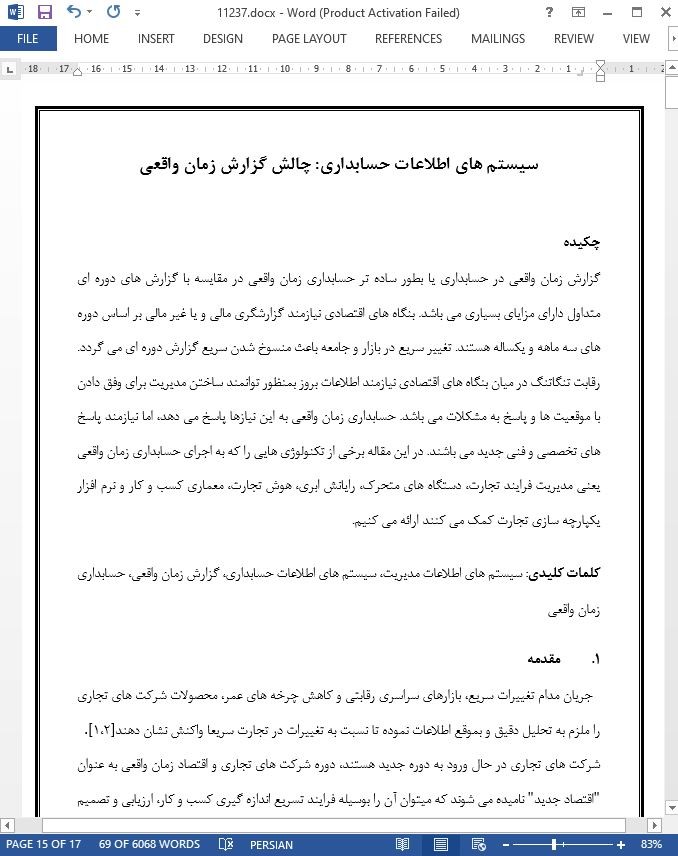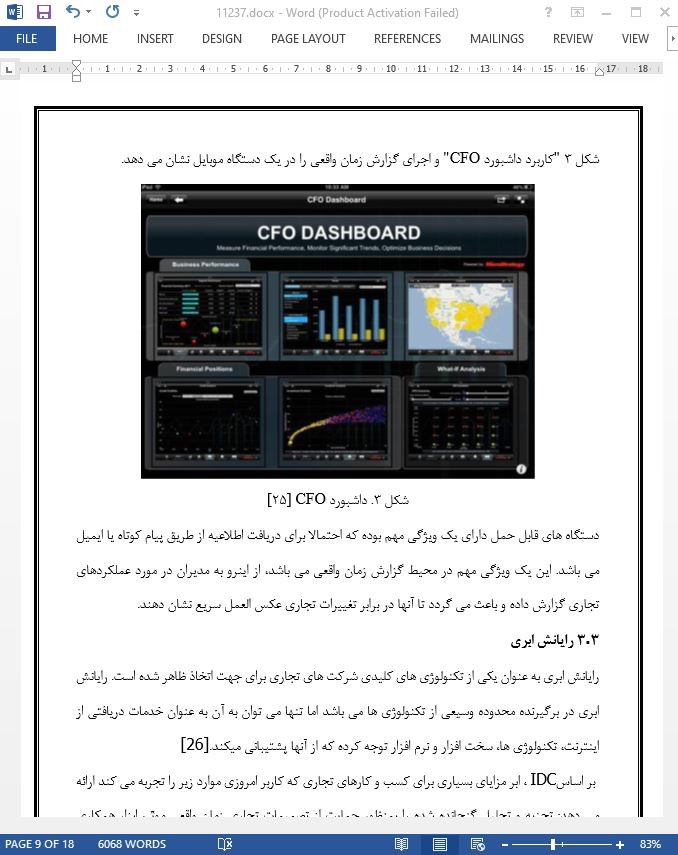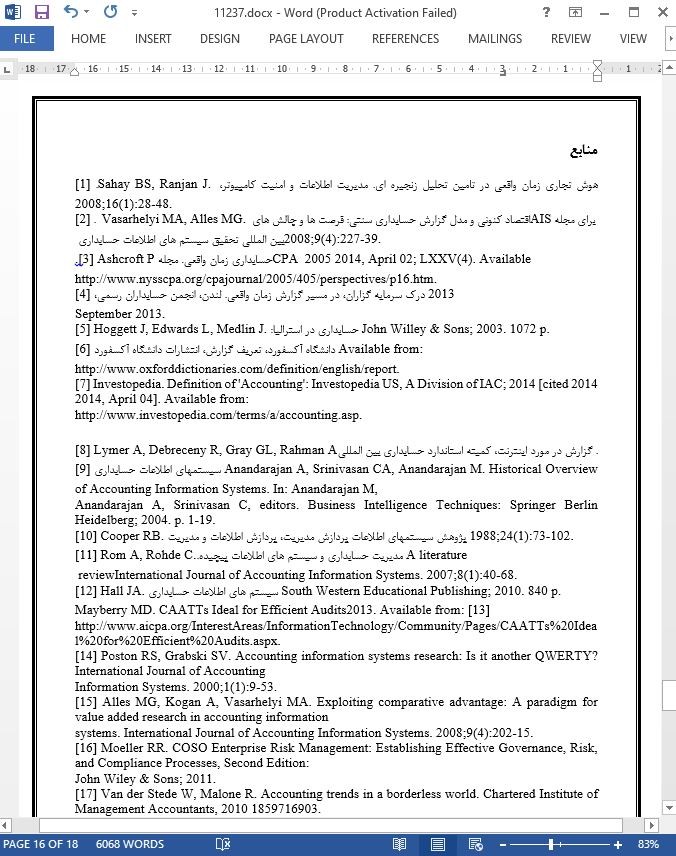
سیستم های اطلاعات حسابداری: چالش گزارش زمان واقعی
چکیده
گزارش زمان واقعی در حسابداری یا بطور ساده تر حسابداری زمان واقعی در مقایسه با گزارش های دوره ای متداول دارای مزایای بسیاری می باشد. بنگاه های اقتصادی نیازمند گزارشگری مالی و یا غیر مالی بر اساس دوره های سه ماهه و یکساله هستند. تغییر سریع در بازار و جامعه باعث منسوخ شدن سریع گزارش دوره ای می گردد. رقابت تنگاتنگ در میان بنگاه های اقتصادی نیازمند اطلاعات بروز بمنظور توانمند ساختن مدیریت برای وفق دادن با موقعیت ها و پاسخ به مشکلات می باشد. حسابداری زمان واقعی به این نیازها پاسخ می دهد، اما نیازمند پاسخ های تخصصی و فنی جدید می باشند. در این مقاله برخی از تکنولوژی هایی را که به اجرای حسابداری زمان واقعی یعنی مدیریت فرایند تجارت، دستگاه های متحرک، رایانش ابری، هوش تجارت، معماری کسب و کار و نرم افزار یکپارچه سازی تجارت کمک می کنند ارائه می کنیم.
1. مقدمه
جریان مدام تغییرات سریع، بازارهای سراسری رقابتی و کاهش چرخه های عمر، محصولات شرکت های تجاری را ملزم به تحلیل دقیق و بموقع اطلاعات نموده تا نسبت به تغییرات در تجارت سریعا واکنش نشان دهند]1،2 .[ شرکت های تجاری در حال ورود به دوره جدید هستند، دوره شرکت های تجاری و اقتصاد زمان واقعی به عنوان "اقتصاد جدید" نامیده می شوند که میتوان آن را بوسیله فرایند تسریع اندازه گیری کسب و کار، ارزیابی و تصمیم توصیف کرد ] 2 [. اقتصاد کنونی چالش جدیدی را به سیستم های اطلاعاتی حسابداری که به عنوان گزارش زمان واقعی می باشد تحمیل می کند.
4. نتایج
امروزه برخی از فعالیت های حسابداری با نگرانی های خاصی مواجه هستند که چالش های خاصی را بوجود می آورند. البته، موفقیت اجرای سیستم اطلاعات حسابداری بر اساس مسائل فنی بوده اما ابعاد دیگر مانند ابعاد مردمی و سازمانی نیز باید در نظر گرفته شوند. راه حل های فنی جدید نیازمند توجه بیشتر بوده و جواب هایی را برای چالش حسابداری گزارش زمان واقعی فراهم می کند.
Abstract
Real-time reporting in accounting or simply real-time accounting offers many benefits when compared to conventional periodic reporting. Traditionally, enterprises require financial or non-financial reporting based on quarterly and annual periods. Yet, the rapid change that occurs on market and society causes this periodic reporting to become quickly outdated. Higher competition among enterprises demands for more updated information to enable management to rapidly adapt to opportunities and answer problems. Real-time accounting addresses these needs, but needs new technological answers. In this article we present some technologies which can help the implementation of real-time accounting, namely, business process management, mobile devices, cloud computing, business intelligence, enterprise architecture and enterprise application integration.
1. Introduction
The running stream of fast changing, increasingly competitive global market and rapidly shortening product life cycles forces enterprises to analyse accurate and timely information, in order to react instantaneously to changes in its business [1, 2]. Enterprises are entering a new era, the era of the real-time enterprises and real-time economy also called the “now economy”, which can be characterized by a substantive acceleration of business measurement, assessment and decision processes [2]. The now economy poses a new challenge to Accounting Information Systems, which is the real-time reporting.
4. Conclusions
Nowadays, some accounting activities face special concerns that represent serious challenges. Of course, the implementation success of an accounting information system depends on technological issues, but other dimensions should be considered, like the people and the organizational dimensions [47, 48]. Yet, new technological solutions deserve a closer attention and may provide answers to the accounting challenge of real time reporting.
چکیده
1. مقدمه
2. گزارش تحت نظر حوزه حسابداری
1.2 ابعاد اطلاعات برای گزارش
2.2 اقتصاد جدید و تاثیر آن بر گزارش حسابداری
3. چالش گزارش زمان واقعی حسابداری و پاسخ های تخصصی
1.3 مدیریت فرایند تجاری
2.3 دستگاه های متحرک
3.3 رایانش ابری
4.3 هوش تجاری
3.5 معماری شرکت های تجاری و نرم افزار یکپارچه سازی آن
4. نتایج
Abstract
1. Introduction
2. Reporting under the accounting domain
2.1. Information dimensions for reporting
2.2. The now economy and its impact on accounting reporting
3. Accounting’s real-time reporting challenge and technological answers
3.1. Business process management
3.2. Mobile devices
3.3. Cloud computing
3.4. Business intelligence
3.5. Enterprise architecture and Enterprise application integration
4. Conclusions
- اصل مقاله انگلیسی با فرمت ورد (word) با قابلیت ویرایش
- ترجمه فارسی مقاله با فرمت ورد (word) با قابلیت ویرایش، بدون آرم سایت ای ترجمه
- ترجمه فارسی مقاله با فرمت pdf، بدون آرم سایت ای ترجمه



